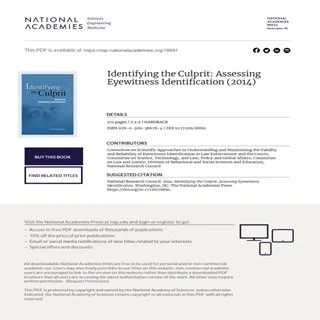By the National Research Council
Eyewitness identifications play an important role in the investigation and prosecution of crimes, but they have also led to erroneous convictions. In the fall of 2013, the Laura and John Arnold Foundation called upon the National Academy of Sciences (NAS) to assess the state of research on eyewitness identification and, when appropriate, make recommendations. In response to this request, the NAS appointed an ad hoc study committee that we have been privileged to co-chair. The committee’s review analyzed relevant published and unpublished research, external submissions, and presentations made by various experts and interested parties. The research examined fell into two general categories: (1) basic research on vision and memory and (2) applied research directed at the specific problem of eyewitness identification. Basic research has progressed for many decades, is of high quality, and is largely definitive. Research of this category identifies principled and insurmountable limits of vision and memory that inevitably affect eyewitness accounts, bear on conclusions regarding accuracy, and provide a broad foundation for the committee’s recommendations. Through its review, the committee came to recognize that applied eyewitness identification research has identified key variables affecting the accuracy of eyewitness identifications. This research has been instrumental in informing law enforcement, the bar, and the judiciary of the frailties of eyewitness identification testimony. Such past research has appropriately identified the variables that may affect an individual’s ability to make an accurate identification. However, given the complex nature of eyewitness identification, the practical difficulties it poses for experimental research, and the still ongoing evolution of statistical procedures in the field of eyewitness identification research, there remains at the time of this review substantial uncertainty about the effect and the interplay of these variables on eyewitness identification. Nonetheless, a range of practices has been validated by scientific methods and research and represents a starting place for efforts to improve eyewitness identification procedures. In this report, the committee offers recommendations on how law enforcement and the courts may increase the accuracy and utility of eyewitness identifications. In addition, the committee identifies areas for future research and for collaboration between the scientific and law enforcement communities. We are indebted to those who addressed the committee and to those who submitted materials to the committee, and we are particularly indebted to the members of the committee. These individuals devoted untold hours to the review of materials, meetings, conference calls, analyses, and report writing. This report is very much the result of the enormous contributions of an engaged community of scholars and practitioners who reached their findings and recommendations after many vigorous and thoughtful discussions. We also would like to thank the project staff, Karolina Konarzewska, Steven Kendall, Arlene Lee, and Anne-Marie Mazza, and editor Susanna Carey for their dedication to the project and to the work of the committee.
National Research Council. 2014. Identifying the Culprit: Assessing Eyewitness Identification. Washington, DC: The National Academies Press.



